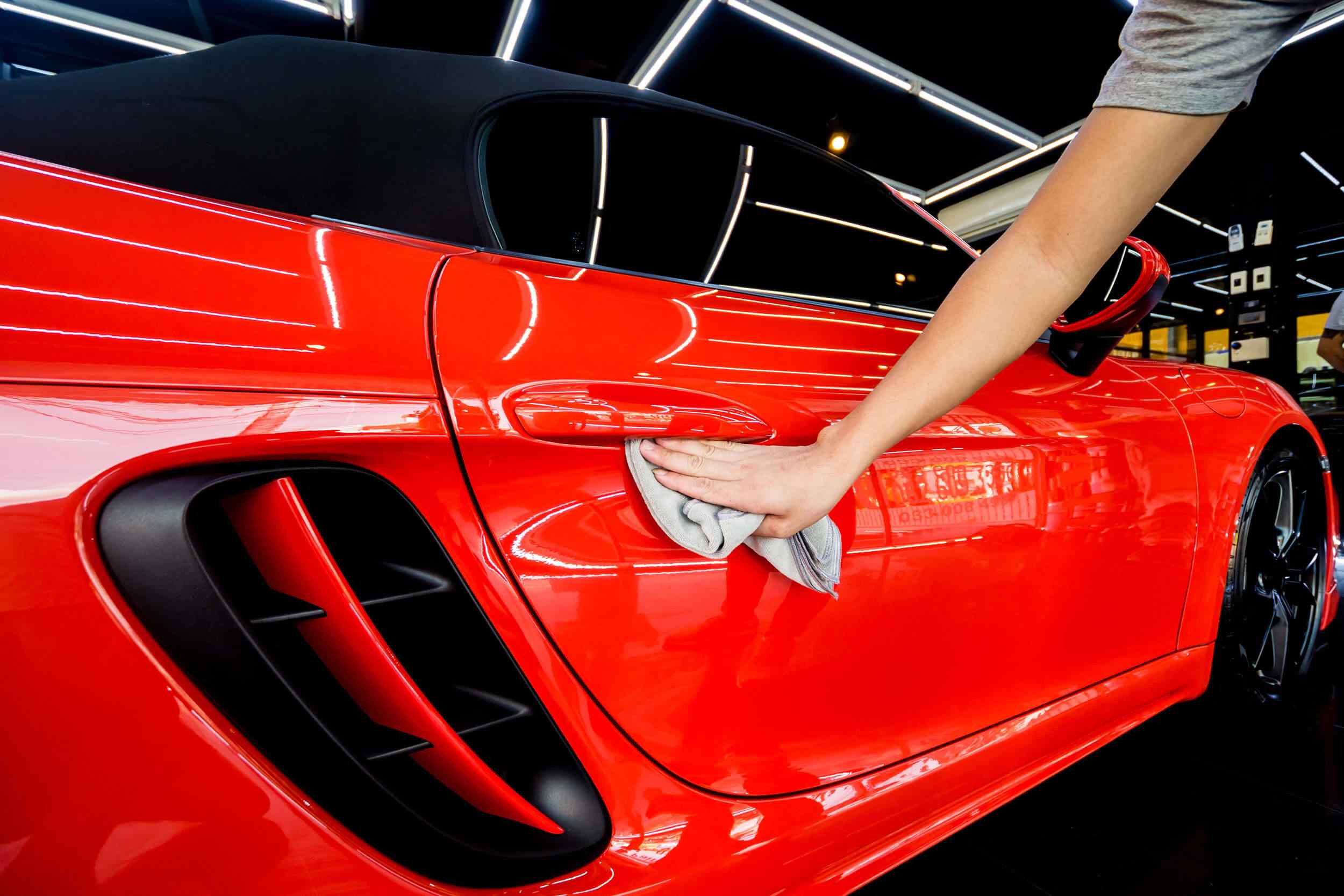Ceramic coating has become increasingly popular in the automotive industry as a way to protect and enhance the appearance of vehicles. This innovative technology offers a range of benefits that go beyond traditional wax or sealant, making it a preferred choice for car enthusiasts and professionals alike. In this article, we will explore what ceramic coating is, how it works, its benefits, and how to apply and maintain it on your vehicle.
Key Takeaways
- Ceramic coating is a protective layer applied to a vehicle's exterior to enhance its appearance and protect it from damage.
- Benefits of ceramic coating include protection from UV rays, scratches, and chemical damage, as well as easier cleaning and maintenance.
- Ceramic coating works by creating a chemical bond with the vehicle's surface, forming a durable and long-lasting protective layer.
- There are two types of ceramic coating: professional-grade and consumer-grade, with varying levels of durability and protection.
- Applying ceramic coating involves thorough cleaning and preparation of the vehicle's surface, followed by careful application of the coating and allowing it to cure.
What is Ceramic Coating?
Ceramic coating is a liquid polymer that is applied to the exterior of a vehicle to create a protective layer. Unlike traditional wax or sealant, which sits on top of the paintwork, ceramic coating chemically bonds with the surface to form a strong and durable barrier. This barrier provides protection against UV rays, scratches, chemical stains, and other environmental contaminants.One of the key differences between ceramic coating and traditional wax or sealant is its longevity. While wax or sealant may last for a few months at most, ceramic coating can last for several years with proper care. This makes it a cost-effective solution for those looking for long-term protection and enhancement for their vehicles.
Benefits of Ceramic Coating for Your Vehicle
There are several benefits to applying ceramic coating to your vehicle. Firstly, it provides protection against UV rays, which can cause fading and damage to the paintwork over time. The ceramic coating acts as a barrier, reflecting the harmful rays and preventing them from penetrating the surface.Secondly, ceramic coating offers enhanced gloss and shine to your vehicle. The smooth and hydrophobic nature of the coating allows water to bead up and slide off easily, leaving behind a clean and shiny surface. This not only improves the overall appearance of your vehicle but also makes it easier to clean and maintain.Lastly, ceramic coating provides long-lasting durability. Unlike traditional wax or sealant that needs to be reapplied every few months, ceramic coating can last for several years. This means that you can enjoy the benefits of protection and enhancement for an extended period of time, without the hassle of frequent reapplication.
How Does Ceramic Coating Work?
| Question | Answer |
|---|
| What is ceramic coating? | Ceramic coating is a liquid polymer that is applied to the exterior of a vehicle to protect it from external elements. |
| How does ceramic coating work? | Ceramic coating works by creating a protective layer on the surface of the vehicle that repels water, dirt, and other contaminants. It also provides a high level of UV protection, preventing the paint from fading over time. |
| What are the benefits of ceramic coating? | The benefits of ceramic coating include protection from scratches, swirl marks, and other types of damage. It also makes the vehicle easier to clean and maintain, and can enhance its overall appearance. |
| How long does ceramic coating last? | The lifespan of ceramic coating can vary depending on the quality of the product and how well it is maintained. Generally, it can last anywhere from 2-5 years. |
| Is ceramic coating worth the investment? | Many car owners believe that ceramic coating is worth the investment due to the long-lasting protection it provides and the ease of maintenance it offers. However, it is important to do your research and choose a reputable product and installer. |
Ceramic coating works by chemically bonding with the surface of your vehicle. When applied, the liquid polymer forms a strong and durable layer that adheres to the paintwork. This layer creates a protective barrier that is resistant to UV rays, scratches, chemical stains, and other environmental contaminants.The chemical bonding process occurs at a molecular level, with the ceramic coating filling in the microscopic pores and imperfections on the surface of the paintwork. This creates a smooth and hydrophobic surface that repels water, dirt, and other contaminants. The result is a glossy and shiny finish that is easy to clean and maintain.
Types of Ceramic Coating
There are several types of ceramic coatings available on the market, each with its own unique properties and application process. The most common types include SiO2 (silicon dioxide) coatings, TiO2 (titanium dioxide) coatings, and hybrid coatings.SiO2 coatings are known for their durability and hydrophobic properties. They create a strong bond with the surface of the vehicle and provide long-lasting protection against UV rays, scratches, and chemical stains. TiO2 coatings, on the other hand, offer enhanced self-cleaning properties. They have photocatalytic properties that help break down dirt and grime when exposed to sunlight.Hybrid coatings combine the benefits of both SiO2 and TiO2 coatings. They offer excellent protection against UV rays, scratches, chemical stains, and other environmental contaminants. Hybrid coatings also provide enhanced gloss and shine to your vehicle's paintwork.
How to Apply Ceramic Coating to Your Vehicle
Applying ceramic coating to your vehicle requires careful preparation and attention to detail. Here is a step-by-step guide to help you through the process:1. Wash and dry your vehicle thoroughly to remove any dirt, grime, or contaminants from the surface.2. Clay bar the paintwork to remove any embedded contaminants that cannot be removed through washing alone.3. Polish the paintwork to remove any imperfections and create a smooth surface for the ceramic coating to bond with.4. Apply the ceramic coating using an applicator pad or microfiber cloth. Work in small sections, applying the coating in a thin and even layer.5. Allow the coating to cure for the recommended time, usually between 24 to 48 hours. Avoid exposing the vehicle to water or extreme temperatures during this time.6. After the curing period, buff off any excess residue using a clean microfiber cloth.
Maintenance and Care for Ceramic Coating
To maintain the effectiveness of your ceramic coating, it is important to follow a regular maintenance routine. Here are some tips to help you care for your ceramic-coated vehicle:1. Wash your vehicle regularly using a pH-neutral car shampoo and a soft microfiber wash mitt. Avoid using harsh chemicals or abrasive materials that can damage the coating.2. Dry your vehicle thoroughly after washing to prevent water spots from forming on the surface.3. Use a ceramic coating booster or spray sealant every few months to enhance the hydrophobic properties of the coating and maintain its shine.4. Avoid parking your vehicle under trees or in areas where it is exposed to bird droppings, tree sap, or other environmental contaminants that can damage the coating.5. If necessary, use a mild paint cleaner or polish to remove any stubborn stains or imperfections from the surface.
How Long Does Ceramic Coating Last?
The lifespan of ceramic coating can vary depending on several factors, including the quality of the coating, the application process, and how well it is maintained. On average, a ceramic coating can last between two to five years with proper care.However, it is important to note that the longevity of the coating can be affected by external factors such as the climate, driving conditions, and frequency of washing. Vehicles that are exposed to harsh weather conditions or frequent washing may require more frequent reapplication of the coating.
Cost of Ceramic Coating and Is It Worth It?
The cost of ceramic coating can vary depending on several factors, including the size of the vehicle, the type of coating used, and the complexity of the application process. On average, ceramic coating can cost anywhere from a few hundred dollars to a few thousand dollars.While ceramic coating may be more expensive than traditional wax or sealant, it offers long-term protection and enhancement for your vehicle. The durability and longevity of ceramic coating make it a cost-effective solution in the long run, as it eliminates the need for frequent reapplication and provides superior protection against UV rays, scratches, and chemical stains.
Common Misconceptions About Ceramic Coating
There are several common misconceptions about ceramic coating that need to be clarified. One misconception is that ceramic coating is scratch-proof. While ceramic coating can provide a certain level of scratch resistance, it is not completely immune to scratches. It is still important to take proper care of your vehicle and avoid abrasive materials or techniques that can damage the coating.Another misconception is that ceramic coating is a one-time application. While ceramic coating can last for several years, it may require periodic maintenance and reapplication to maintain its effectiveness. This is especially true for vehicles that are exposed to harsh weather conditions or frequent washing.
Choosing the Right Ceramic Coating for Your Vehicle
When selecting a ceramic coating for your vehicle, there are several factors to consider. Firstly, consider the type of vehicle you have and its specific needs. For example, if you have a luxury or high-performance vehicle, you may want to opt for a high-quality ceramic coating that offers superior protection and enhancement.Secondly, consider the driving conditions and climate in which your vehicle will be exposed. If you live in an area with harsh weather conditions or extreme temperatures, you may want to choose a ceramic coating that is specifically designed to withstand these conditions.Lastly, consider your budget and the level of maintenance you are willing to commit to. Some ceramic coatings require more frequent maintenance and reapplication than others, so it is important to choose one that fits your lifestyle and preferences.In conclusion, ceramic coating offers a range of benefits for your vehicle, including protection against UV rays, scratches, and chemical stains, enhanced gloss and shine, and long-lasting durability. By understanding how ceramic coating works, how to apply and maintain it, and the different types available, you can make an informed decision about whether it is the right choice for your vehicle. With proper care and maintenance, ceramic coating can provide long-term protection and enhancement for your vehicle, making it a worthwhile investment for car enthusiasts and professionals alike.If you're interested in ceramic coating for your vehicle, you might also want to check out this article on Fleet Details about a car detailing shop serving Rockford, IL that recently opened in Cherry Valley, IL. They offer a range of services including ceramic coating to protect your vehicle's paint and keep it looking pristine. To learn more about their offerings and how ceramic coating can benefit your car, check out the article
here.





